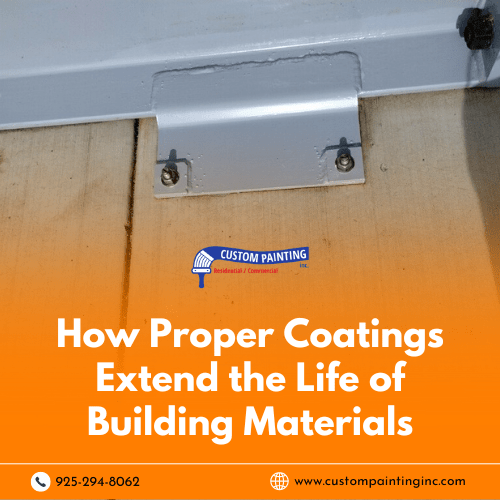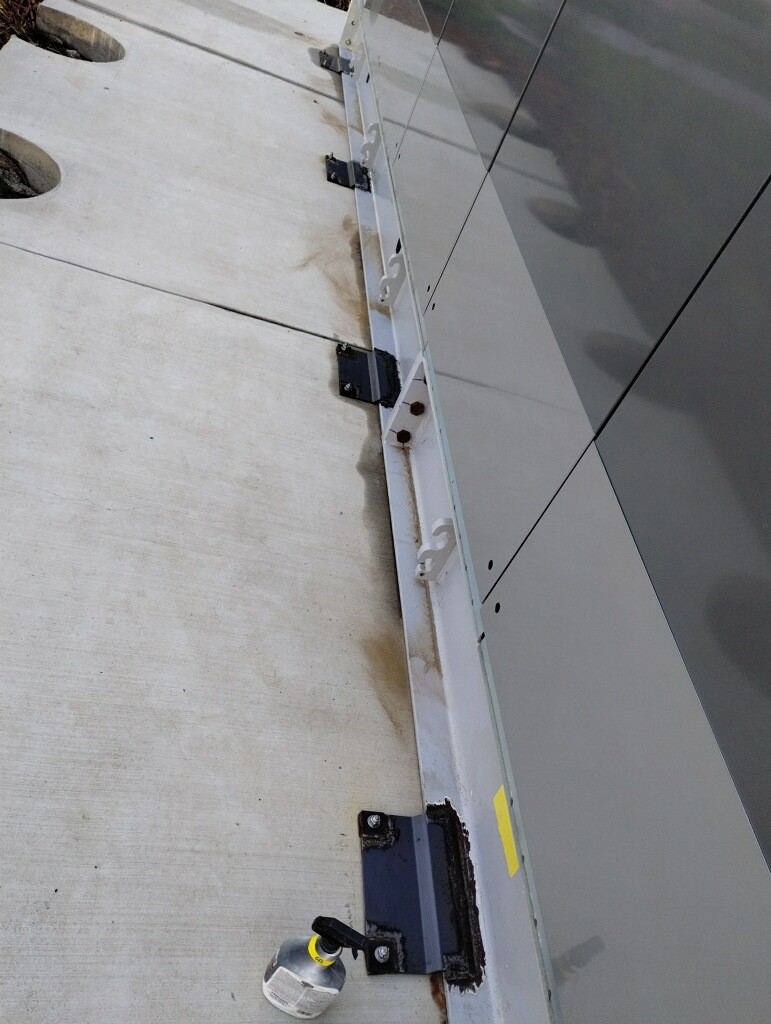Keeping building materials in good shape is very important. One of the best ways to do this is by covering them with a special layer of paint. This is not just about making them look nice; it’s about protecting them from things that can cause damage, like water, sunlight, and chemicals. The Custom Painting, Inc. team recently finished a painting task involving 76 horizontal brackets. Some might wonder why painting them is essential, but in fact, there are benefits that you can get from coating building materials such as brackets.

This article will discuss why painting parts of buildings is so important, especially the metal pieces that hold things together, like brackets. We’ll also share some tips on doing it right so these parts last longer and save money in the long run.
The Importance of Protective Coatings for Building Materials
Protecting building materials is crucial for keeping structures strong and looking good over time. This section explores why protective coatings, especially paint, are important for building materials.
Why Protective Coatings Matter
- Protection Against Elements: Buildings face many challenges from the weather and environment. Rain, snow, and even the sun can damage materials over time. Coatings like paint help block out moisture, prevent rust on metal parts like brackets, and shield the material from harmful UV rays that can weaken and fade materials.
- Enhancing Durability: A good coat of paint does more than just beautify; it adds an extra layer of protection. This means that building materials can withstand wear and tear better, reducing the need for frequent repairs or replacements. It’s especially important for parts of the building that hold it together, as their integrity is vital for safety.
- Chemical Resistance: In areas where pollution or chemical exposure is a concern, protective coatings can safeguard against these harsh substances. For example, in industrial zones, chemicals in the air can speed up the corrosion process in metals. A protective layer of paint can keep these harmful substances at bay, preserving the material’s strength.
The Role of Paint in Protecting Building Materials
Choosing to apply a protective coating, like paint, to building materials is a smart decision for several reasons:
- Creates a Barrier: Paint acts as a barrier, preventing direct contact between the material and the damaging elements. This barrier effect is particularly important for outdoor components of a building, which are exposed to the elements all the time.
- Cost-Effective Maintenance: While it might seem like an extra expense initially, investing in quality protective coatings can save money in the long run. Extending the life of building materials reduces the frequency and cost of repairs or replacements.
- Versatility: Paint is not just for wood or metal; it can be applied to various materials, each with its own specific type of paint designed to offer the best protection. This versatility makes it an excellent choice for protecting different parts of a building including an old rusty door..
Protective coatings like paint are essential for maintaining the health and appearance of building materials. They protect against environmental damage, enhance durability, and offer a cost-effective way to preserve buildings. By understanding the importance of these coatings, we can make informed decisions about how to best care for our structures.
The Benefits of Painting Building Materials
Applying paint to building materials is more than just an aesthetic choice—it’s a smart way to ensure the longevity and durability of a building’s components. This section dives into the various benefits of painting building materials, highlighting why it’s a crucial practice.
- Moisture Barrier: One of the leading causes of damage to building materials is moisture. Paint provides a seal that removes water and moisture, preventing wood rot and metal rust.
- Sunlight Protection: UV rays can degrade materials over time, causing them to weaken and fade. Paint acts as a sunscreen for building materials, protecting them from the sun’s harmful effects.
- Visual Appeal: A fresh coat of paint can dramatically improve the look of a building, making it more inviting and appealing. This is important not only for homes but also for commercial buildings where appearance can influence customer perceptions.
- Color Choices: Painting offers endless possibilities in colors and finishes, allowing for customization that can reflect a building’s character or the owner’s style.
- Reflective Properties: Certain types of paint can reflect more sunlight, helping to keep buildings cooler in the summer. This can lead to significant energy savings by reducing the need for air conditioning.
- Maintenance Costs: By protecting building materials from damage, paint can reduce the need for costly repairs and replacements over the life of a building.
- Value Preservation: Well-maintained buildings with protective paint coatings tend to retain or even increase in value over time.
- Lead Stabilization: In older buildings, painting over surfaces with lead-based paint can encapsulate harmful lead particles, reducing the risk of exposure.
- Fire Resistance: Some paints are formulated to be fire-resistant, adding an extra layer of safety to buildings by slowing the spread of fire.
- Low-VOC Paints: Many modern paints are designed to be low in volatile organic compounds (VOCs), which harm the environment and human health. The Low-VOC paints contribute to healthier indoor air quality and a smaller ecological footprint.
Specific Advantages of Painting Brackets and Similar Materials
Brackets, integral components supporting various structures within buildings, require special attention to ensure their longevity and functionality. Painting these and similar materials offers several specific advantages that contribute to the overall integrity and durability of a building.
- Moisture Resistance: Brackets, often made of metal, are susceptible to rust and corrosion when exposed to moisture. A coat of paint seals the surface, preventing water from directly contacting the metal.
- Chemical Barrier: In environments with chemical vapors or pollutants, paint can provide a protective barrier that prevents these substances from reacting with the bracket material, thus avoiding corrosion and degradation.
- Strength Preservation: By preventing corrosion, paint helps maintain the original strength of the bracket. This is crucial for the structural integrity of the building, as weakened brackets can lead to failures in the support they provide.
- Longevity: Applying paint significantly extends brackets and similar materials’ lifespan. This means less frequent replacements, contributing to the building’s design and construction sustainability.
- Visual Consistency: Paint allows brackets to blend in with or complement the surrounding materials, contributing to a cohesive aesthetic throughout the building.
- Customization: With a wide range of colors and finishes, painting brackets can add visual interest or align with design themes.
- Reduced Replacement Frequency: The extended lifespan of painted brackets translates into lower long-term costs, greatly diminishing the need for replacements.
- Ease of Inspection: Painted surfaces are easier to inspect for signs of wear and damage. This simplifies maintenance routines and helps identify issues before they escalate into major problems.
Best Practices in Applying Protective Paints
To maximize the protective and aesthetic benefits of paint on building materials, it’s crucial to adhere to best practices from preparation to application. This section outlines the key steps and considerations to ensure the longevity and effectiveness of protective paints.
Surface Preparation: The Foundation of Durability
- Cleaning: Begin with a clean surface by removing dirt, grease, and old, flaking paint. This might include using a rust remover or a wire brush to eliminate metal corrosion.
- Sanding: Smoothing out the surface ensures that the paint adheres well. Sanding should be thorough for wooden materials, aiming for an even, slightly rough texture to enhance grip.
- Priming: A primer is essential for most surfaces, especially metals and porous materials. It provides a good base for the paint to stick to and can enhance its protective qualities, like rust inhibition.
Choosing the Right Paint
- Material Compatibility: Select a paint formulated for your working material. For instance, specific paints for wood, metal, concrete, etc., are designed to offer optimal protection and finish.
- Environmental Considerations: Consider the environmental conditions the material will be exposed to. Use waterproof, UV-resistant, or temperature-resistant paints as needed.
- Safety and Sustainability: Opt for paints with low volatile organic compounds (VOCs) to ensure better indoor air quality and minimize environmental impact.
Application Techniques
- Tool Selection: Choose the right tool for the job. Brushes are great for detailed work and small areas, rollers can cover large, flat surfaces efficiently, and sprayers offer a uniform coat for intricate or uneven surfaces.
- Even Coating: Apply paint in thin, even layers. Multiple light coats are better than a single thick coat, as they dry faster and reduce the risk of drips or unevenness.
- Drying Times: Adhere to recommended drying times between coats. Rushing this process can lead to tacky surfaces, incomplete curing, and less durable finishes.
Maintenance and Touch-ups
- Regular Checks: Inspect painted surfaces regularly for signs of wear or damage, such as cracking, peeling, or fading. Early detection allows for prompt touch-ups, extending the lifespan of the protective paint.
- Proper Touch-ups: When necessary, clean and prep the area as you would for a full paint job. Matching the original paint in type and color ensures a seamless repair.
Innovative Approaches and Materials
The paint industry continually evolves, with new products designed to offer better protection, ease of application, and environmental benefits. Keeping abreast of these developments can provide opportunities to use more effective, durable, and eco-friendly options.
By following these best practices, you can ensure that your protective painting efforts yield the best possible results in aesthetics and longevity. Proper preparation, choosing the right products, and careful application go a long way in safeguarding building materials against the elements and wear, preserving them for years.
Conclusion
Painting building materials in the San Ramon are is not just about making them look nice; it’s crucial to protecting and extending their lifespan. By following the best practices for surface preparation, choosing the right paint, and applying it correctly, you can save on future repairs and keep your building in top shape for years.
If you have any questions or need professional help with your painting project, don’t hesitate to contact Custom Painting, Inc. at 925-294-8062 or use the contact form on our website to send us a message. We’re here to help you get the best results for your building.



